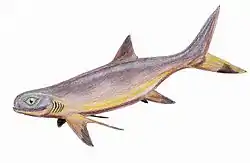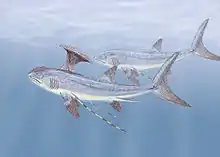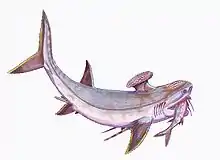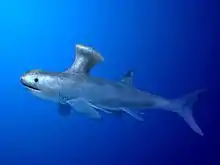Symmoriida
Symmoriida is an extinct order of holocephalians[1] that contains three families. It was synonymized subjectively with Cladodontida by Lund (1986); it was corrected as Symmoriiformes by Maisey (2008). It was assigned to Cladoselachii by Goto et al. (1988); to Elasmobranchii by Williams (1998), and to Chondrichthyes by Sepkoski in 2002 and by Maisey in 2008. In the fossil record, they appear at the beginning of the Carboniferous. Most of them died out at the start of the Permian, but Dwykaselachus is known from the Artinskian-Kungurian of South Africa.[1] However, teeth described from the Valanginian of France[2] and Austria[3] indicates that members of the family Falcatidae might have survived until the Early Cretaceous.
| Symmoriida | |
|---|---|
 | |
| Symmorium | |
| Scientific classification | |
| Kingdom: | Animalia |
| Phylum: | Chordata |
| Class: | Chondrichthyes |
| Subclass: | Holocephali |
| Order: | †Symmoriida Zangerl, 1981 |
| Families | |
Fossil distribution
Fossil evidence of Symmoriida have been found at Bear Gulch, Fergus County, Montana,[4] Bethel Quarry, Pike County, Indiana, Kinshozan quarry, Alaska, Gifu Prefecture, Japan, Bashkortostan, Russian Federation[5] and possibly also France.
Gallery
References
- Coates M.; Gess R.; Finarelli J.; Criswell K.; Tietjen K. (2016). "A symmoriiform chondrichthyan braincase and the origin of chimaeroid fishes". Nature. 541: 208–211. doi:10.1038/nature20806. PMID 28052054.
- Guillaume Guinot; Sylvain Adnet; Lionel Cavin & Henri Cappetta (2013). "Cretaceous stem chondrichthyans survived the end-Permian mass extinction". Nature Communications. 4: Article number: 2669. doi:10.1038/ncomms3669. PMID 24169620.
- Feichtinger, Iris; Engelbrecht, Andrea; Lukeneder, Alexander; Kriwet, Jürgen (2020-07-02). "New chondrichthyans characterised by cladodont-like tooth morphologies from the Early Cretaceous of Austria, with remarks on the microstructural diversity of enameloid". Historical Biology. 32 (6): 823–836. doi:10.1080/08912963.2018.1539971. ISSN 0891-2963.
- Lund R (1982). "Harpagofututor volsellorhinus new genus and species (Chondrichthyes, Chondrenchelyiformes) from the Namurian Bear Gulch Limestone, Chondrenchelys problematica Traquair (Visean), and their sexual dimorphism". Journal of Paleontology. 56 (4): 938–958., authorized by John Alroy, Paleobiology Database: Bear Gulch site
- Ivanov A (2005). "Early Permian chondrichthyans of the middle and south Urals". Revista Brasileira de Paleontologia. 8 (2): 127–138. doi:10.4072/rbp.2005.2.05.




